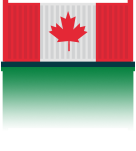Why U.S. Tariffs Are Rewriting the Rules of Global Logistics
With Trump back in office and a renewed trade war unfolding, tariffs are no longer just a distant threat or temporary disruption. They’re here and reshaping how businesses move goods across borders.
In recent months, the U.S. has announced, delayed, and reimposed tariffs of up to 25% on goods from key trade partners like China, Mexico, and Canada. From finished goods to raw materials like steel and aluminum, the scope of these tariffs is sweeping—and unpredictable.
Enforcement dates shift week by week. Temporary exemptions are granted or withdrawn at a moment’s notice. But the trend is clear: tariff volatility is here to stay and it’s putting mounting pressure on global supply chains.
As a result, businesses are being forced to reassess how—and where—they move goods. Rising landed costs, customs slowdowns, and cross-border bottlenecks are quickly becoming the norm.
For international companies shipping into North America, these aren’t just operational hurdles—they’re strategic threats to profitability, market access, and long-term growth.
The question isn’t if tariffs will disrupt your business—it’s how prepared you are to outmaneuver them.
Need a deeper look at how cross-border shipping really works? Explore our guide to cross-border logistics.
The Cost of Inaction: How Tariffs Disrupt Cross-Border Trade
Tariffs aren’t just driving up costs at the border. They’re forcing businesses to rethink their entire logistics model. The traditional path—shipping into the U.S. first, then distributing across North America—is now riddled with delays, uncertainty, and extra costs.
Every new tariff announcement triggers a scramble to recalculate margins. Every customs delay risks missed delivery windows and frustrated customers. And for small to mid-sized international companies, these ripple effects can quickly stall growth—or close off critical market access altogether.
In this volatile trade environment, reactive logistics is no longer enough. Businesses need a proactive, flexible strategy—one that’s designed to minimize risk, protect profit, and avoid unnecessary duties from the outset.
That’s where a trusted third-party logistics (3PL) company like McKenna Logistics Centres offers a true strategic advantage.
Curious how companies stay competitive with cross-border logistics? Explore our approach to smarter, more scalable logistics solutions.
What International Businesses Need: A Flexible Logistics Strategy
In today’s unpredictable trade environment, logistics can no longer be an afterthought. With tariffs shifting weekly, lead times getting longer, and cross-border costs rising fast, international businesses—especially small and mid-sized ones—need to rethink not just where they ship goods, but how. Designed specifically for cross-border logistics into Canada and the U.S., a flexible strategy gives businesses more control over tariffs, timing, and costs.
So, what does a modern, tariff-resilient logistics strategy look like?
1. It’s Proactive, Not Reactive
Waiting until duties are imposed or scrambling when a policy changes is a costly game. Smart businesses plan ahead, build flexibility into their supply chain, and design for uncertainty.
2. It’s Built Around Market Access
A strong logistics model supports seamless access to both Canadian and U.S. markets—without being blindsided by trade barriers, border slowdowns, or unexpected duties.
3. It’s Inventory-Efficient
Stockpiling inventory in the U.S. can trigger higher tariffs that tie up working capital. A more strategic model keeps inventory centralized in Canada, with cross-border shipping driven by actual demand.
Want to learn more about warehousing strategies? Check out our article on three key storage and warehousing services to boost efficiency.
4. It Defers Duties and Preserves Cash Flow
Why pay duties on your full shipment upfront? A flexible approach allows you to delay or minimize tariff costs by moving goods into the U.S. only when they’re sold—keeping capital working in your business.
And while programs like Duty Drawback may offer refunds on tariffs paid, it’s important to note that if your goods are eligible for this program, the process of getting those funds returned can take months. In that time, capital is tied up, impacting your ability to use it productively until it is released.
In short, international businesses need a supply chain strategy that can adapt in real time—without sacrificing speed, control, or margin.
That’s exactly what McKenna Logistics Centres’ Canada-based approach is built to deliver.
How McKenna Logistics Centres Help You Avoid U.S. Tariffs
The key to avoiding unnecessary U.S. tariffs isn’t loopholes—it’s logistics.
Why the Traditional Approach Falls Short
Most international businesses follow a familiar path: ship goods into the U.S., then distribute to Canada from there. But with tariffs reaching up to 25%, this strategy can quickly erode profit margins.
While programs like Duty Drawback offer potential refunds, they’re often complex, time-consuming, and limited in scope. Many businesses end up paying duties on goods that never even remain in the U.S.—tying up capital and adding avoidable costs.
To make matters worse, tariff policy changes are likely to continue throughout the current U.S. administration. For companies still relying on a U.S.-first logistics model, that means more volatility, less predictability, and tighter cash flow.
A Smarter, Canada-Based North American Supply Chain Strategy
That’s why McKenna Logistics Centres offers a smarter alternative:
A Canada-based logistics strategy that helps you reduce landed costs, preserve working capital, and stay agile in the face of trade volatility—without needing large volumes of inventory to get started.
This supply chain model doesn’t just help you sidestep today’s tariffs—it helps temper the impact of shifting trade policies on your business, allowing you to maintain control, reduce risk, and plan with greater confidence.
Here’s how it works:
Import Directly into Canada
Rather than sending goods through the U.S. and triggering tariffs on arrival, McKenna Logistics Centres enables you to ship goods straight from the country of origin into Canada. This is especially beneficial for direct-to-consumer (DTC) businesses and eCommerce brands looking for efficient, tariff-free entry into North America.
Benefits include:
- Avoiding immediate exposure to U.S. tariffs
- Faster, more predictable customs clearance through Canadian ports
- Immediate access to the Canadian market
This logistics strategy not only helps avoid U.S. tariffs, but also positions your business for scalable, cross-border growth in Canada.
Fulfill Canadian Orders with Precision
Once your goods arrive, McKenna Logistics Centres provides full-service Canadian warehousing and fulfillment, including secure storage, pick and pack, and last-mile delivery. Whether you’re fulfilling ongoing eCommerce demand or managing small-batch product drops, you can start shipping into the Canadian market quickly without needing to hold large volumes of inventory.
Want to stay ahead of the curve in warehousing trends? Read our latest warehousing industry insights.
Store Inventory and Fulfill on Demand
Rather than paying duties on a shipment upfront, you can warehouse inventory in Canada and defer cross-border shipping until U.S. orders are placed.
This approach allows you to:
- Delay or reduce duty payments
- Protect cash flow and minimize risk
- Avoid overpaying on unsold or slow-moving inventory
- Maintain U.S. market access without unnecessary cost
Need a more strategic warehousing plan tailored to eCommerce? Explore how our warehousing solutions support growing online brands.
Your Strategic 3PL Partner for Global Growth
Whether you’re importing consumer electronics, houseware, or sporting goods, McKenna Logistics Centres gives you the infrastructure, expertise, and support to execute your logistics strategy with confidence.
In short: you stay in control. You stay compliant. And you stay competitive.
Future-Proof Your Supply Chain with a Partner Built for What’s Next
Tariffs. Trade wars. Shifting policies. For international businesses, global logistics has never been more complex—or more critical to get right.
That’s why companies across 23 countries trust McKenna Logistics Centres to deliver not just goods but real strategic value. From flexible logistics models to hands-on support and cross-border execution, McKenna Logistics Centres helps businesses stay competitive no matter how unpredictable the market becomes.
And behind that agility? A legacy you can rely on.
McKenna Logistics Centres has been in business since 1950. We’re a third-generation, family-owned Canadian company recently celebrating 75 years of helping businesses scale across North America. Through wars, recessions, pandemics, and policy shake-ups, our commitment to consistency, partnership, and performance has never wavered.
As President John McKenna shared during our 75th anniversary:
“We are a business built on resilience. From our grandfather’s cartage company to today’s modern logistics network, every chapter of our story has been shaped by people who step up, adapt, and deliver. The reason we’ve lasted 75 years isn’t because the world stayed the same—it’s because we never stopped evolving with it.”
Remember: Tariffs may be unpredictable but your logistics partner doesn’t have to be.
Want to see how our cross-border logistics in Canada supports businesses like yours? Explore our order fulfillment capabilities for eCommerce and beyond.
Ready to Avoid U.S. Tariffs and Streamline Your Cross-Border Logistics?
Whether you’re shipping from Asia, Europe, or anywhere in between, McKenna Logistics Centres can help you take control of your supply chain before tariffs take control of your margins.
Our Canada-based logistics strategy is built around what matters most to your business: duty mitigation, inventory flexibility, faster time to market, and long-term resilience.
Let’s build a logistics strategy that works for your business—today and tomorrow.
Contact our expert team to explore a smarter cross-border logistics partnership.
Frequently Asked Questions (FAQ) about Tariffs and Logistics
1. What are tariffs, and how do they affect my business?
Tariffs are taxes imposed on imported goods by a government to protect domestic industries or generate revenue. For businesses importing products, tariffs increase the cost of goods sold, potentially reducing profit margins and making products less competitive in the market. That’s why companies are investing in smarter logistics strategies to avoid U.S. tariffs and better manage cross-border costs between Canada and the U.S.
2. Why are U.S. tariffs increasing again under Trump’s proposed policies?
President Donald Trump has proposed reintroducing or increasing tariffs as part of a protectionist trade policy aimed at encouraging domestic manufacturing and reducing trade deficits. These measures are intended to incentivize companies to produce goods within the United States rather than relying on imports.
3. How do tariffs impact my bottom line when selling into the United States?
Tariffs increase the landed cost of imported goods, which can lead to higher prices for consumers or reduced profit margins for businesses if they choose to absorb the additional costs. This can make products less competitive in the U.S. market and may result in decreased sales.
4. Are tariffs different depending on the type of product I sell?
Yes, tariff rates vary depending on the product’s classification under the Harmonized System (HS) code. Some products may have low or zero tariffs, while others, especially those targeted by specific trade policies, may face higher rates. It’s essential to determine the HS code for your products to understand the applicable tariffs.
5. Do I have to pay tariffs even if my goods just pass through the U.S.?
Not always. If your goods are simply transiting through the U.S. and you use a Foreign Trade Zone (FTZ) or bonded warehouse, you may be able to defer or even eliminate tariffs, as long as the goods don’t officially enter U.S. commerce.
However, without these special programs in place, duties are typically applied as soon as your goods cross the U.S. border—regardless of whether they’re destined for another country.
Working with an experienced logistics partner is key to navigating these programs correctly and remaining compliant.
6. Can I get a refund on U.S. tariffs if my products aren’t sold there?
The U.S. Customs and Border Protection offers a Duty Drawback program that allows for the refund of certain duties, taxes, and fees collected upon importation if the goods are subsequently exported or destroyed. However, the process is complex, and not all products or situations qualify. Many businesses find it more efficient to structure their supply chains to avoid tariffs initially.
7. Is it possible to store my inventory in Canada and only ship to the U.S. when needed?
Yes, companies like McKenna Logistics Centres offer warehousing and fulfillment services in Canada, enabling businesses to store inventory closer to both Canadian and U.S. markets. This setup allows for on-demand shipping to the U.S., aligning duty payments with actual sales.
8. Does routing through Canada delay my shipments or reduce speed to market?
Not necessarily. In many instances, routing through Canada can enhance delivery times by bypassing congested U.S. ports and positioning inventory closer to end customers. Efficient logistics partners can ensure timely delivery to both Canadian and U.S. markets.
9. How much money can I save by avoiding or deferring U.S. tariffs?
The potential savings depend on the specific tariff rates applicable to your products and the volume of goods imported. By deferring duties until the point of sale, businesses can improve cash flow and reduce the financial burden associated with large upfront tariff payments.
10. Are there penalties for trying to avoid tariffs legally?
No, utilizing strategic logistics planning to minimize tariff exposure is a legitimate business practice. Ensuring compliance with all relevant laws and regulations is crucial to avoid legal issues.
11. Will I still need to pay Canadian duties when shipping into Canada?
Yes, Canadian import duties may apply, but they are generally lower and more predictable than U.S. tariffs. Many goods qualify for reduced or zero duties under free trade agreements.
12. Where can I learn more about current U.S. and Canadian tariffs?
Several official government resources are available to help you understand current tariff rates, HS codes, and compliance requirements:
- U.S. Customs and Border Protection (CBP) – Covers duties, regulations, and the Duty Drawback program.
- U.S. Harmonized Tariff Schedule (HTS) – Allows you to search U.S. tariff rates by product classification.
- Canada Border Services Agency (CBSA) – Provides import guidelines, tariff classifications, and duty calculators for Canada.
- Canada Tariff Finder – A helpful tool to determine tariff rates under various trade agreements for goods imported into Canada.
These resources can help you make informed decisions about your cross-border logistics strategy.





